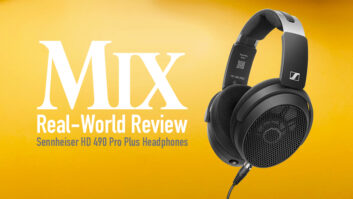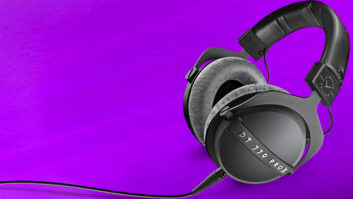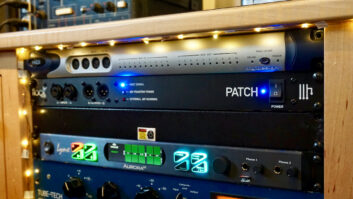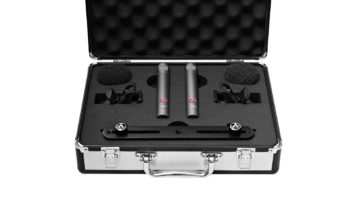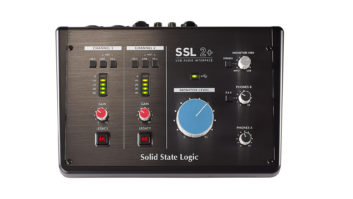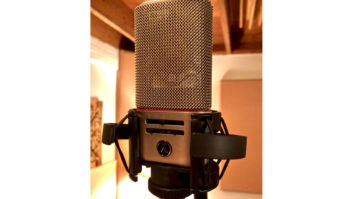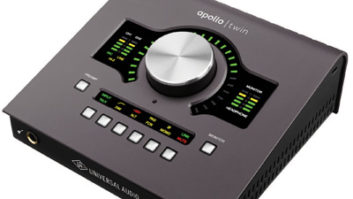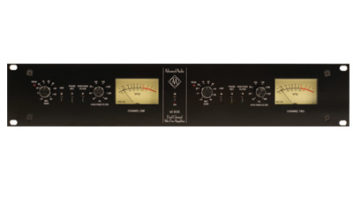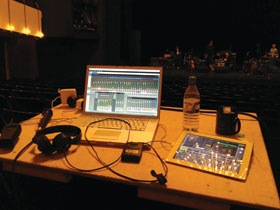
Mobile devices and Wi-Fi have become ingrained in our daily lives, so it’s not terribly surprising to see that these technologies have been adopted as tools in the pro audio world, as well. The Apple iPad has proven to be particularly well suited for this, with its generously sized touchscreen, wireless capability and the relative ease with which custom apps can be written for it.
Performers are taking iPads onstage in place of notebooks full of lyrics and bulky sheet music, while others are incorporating surprisingly powerful instrument apps into their live shows. Increasingly, iPad apps are controlling digital mixers for live sound. PreSonus, with its StudioLive mixers and related apps, was a pioneer in this area, and since has been joined by such companies as Yamaha, Allen & Heath, Behringer, Line 6, Mackie, Soundcraft and Roland.
From small-format mixers to large pro consoles, the latest digital mixers offer wireless connectivity, and most now have iPad apps that can control some or all of their functions. Mackie has even gone so far as to eschew physical faders and knobs on its DL1608, relying on an iPad (or iPads) running its Master Fader app as its mixing surface.
Having mobile mixer control has untethered front-of-house and monitor engineers, making it possible for them to move about freely while still maintaining control of their consoles. This freedom has spawned new workflows, and given live engineers an additional level of flexibility when doing their jobs.
I spoke with a variety of users of these mixer-control apps, mainly live engineers, to find out how they’re integrating them into their work.
WALKABOUT
An iPad mixer app provides freedom to tweak settings while roaming the venue. FOH engineers seem to be particularly enamored of this aspect; not only does it let them hear how things sound from different parts of the room, it also saves them from the tedium of running out front, listening, then running back to the console to make an adjustment, then back out front, etc., or having to relay such messages to a second party.
“Using the MixPad app has been very liberating,” says David J. “Milky” Millward, FOH mixer for Morrissey, as well as acts like Tindersticks and Tokio Hotel; he often uses Allen & Heath’s iLive digital mixing system and controls it with its accompanying MixPad app. “If possible, I try to break up each system I come across into as many usable zones as I can, using the many matrices available on the iLive. That way, when I do the initial system setup, I have full control and can switch zones on and off to listen to them individually and also balance the various elements as I walk around, without having to keep asking the local P.A. techs to go and make adjustments for me, or continually walking back to the console, which can be very time consuming.”

FOH engineer David J. “Milky” Millward controls an Allen & Heath iLive-80 digital console with an iLive MixPad app.
Stephen Pattison, another iLive user, mixes FOH for Spirtualized and Glasvegas, and formerly for Amy Winehouse. He adds: “The app allows you to be where the audience is and hear it from their side of the fence, and control it in real time, so there’s no need to run in and out of FOH to tweak the mix or change the EQ. It’s much more direct.”
Dick Franks is a live mixer for bands on the Seattle club scene, including The Machine, The 5 Johnsons, and No Rules. He has used iPad control apps for both the Mackie DL1608 and the Behringer X32 mixers. “I like to move around at least a few times during the gig with the iPad to check the room,” he says.
In addition to allowing adjustments from different parts of the room, the freedom to roam frees up an engineer to walk up to the stage area to troubleshoot a problem while still mixing. “If something were to happen on stage during the set, such as a mic needing replacement,” says Matthew Woods, engineer for the band The Black Dahlia Murder, “I can grab my iPad and take care of it, and still be able to mute effects, et cetera, from the stage.” Woods recently started mixing on a Yamaha M7CL mixer and using StageMix, Yamaha’s iPad app.
The utility of iPad mixer control is not strictly a boon for engineers. Performers who mix themselves can situate an iPad within a hand’s reach of where they’re standing, allowing them to make mix adjustments without having to walk over to the mixer on the side of the stage.
Singer/keyboardist Nicholas Peper, who plays casuals, clubs and corporate gigs in Southern California, and self-mixes with a Mackie DL1608, tells of an instance at a corporate gig where the ability to roam while controlling the P.A. with Mackie’s Master Fader app came in really handy.
“The corporate bigwig who was paying for everything wanted to make some announcements,” Peper says. “I took that opportunity to stand about 40 feet in front of him with the guests, and made adjustments to his mic level on the fly as needed. Corporate executives almost always have really poor mic technique, and in this case, I was able to save the day without anyone being aware of what I was doing with the iPad.”
Many of the app-controlled mixers can be simultaneously addressed from more than one iPad. “Multiple engineers on this tour use iPads daily, including our current monitor engineer,” says Woods, referring to The Black Dahlia Murder’s recent opening for Dethklok, in which two M7CLs were used, one for FOH and one for monitors. “His and my iPad are both connected to the monitor console so that either one of us can make changes we need from anywhere.”

Singer/keyboardist Nicholas Peper
Using multiple iPads to control one console makes it possible to have a monitor engineer who uses an iPad with a remote app controlling the monitor sends on the FOH console, instead of a dedicated monitor board. For small venue situations, that could work very nicely.
It would certainly be feasible for band members to each have an iPad to control their own monitor level. For many bands, that could lead to a feedback frenzy, but with enough discipline, it could allow a band without a dedicated monitor mixer to avoid those wild gesticulations to the FOH mixer to turn them up. PreSonus makes an app called Qmix, which will run on iPhone, iPod touch or iPad, and is designed to allow musicians to control their own mixes.
TURN ME UP!
Remote control apps have been a major boon for monitor engineers. Brian Foisy mixes monitors for Al Jarreau, Dave Koz and others, often using a Yamaha PM5D or M7CL mixer, and gets plenty of use out of an iPad running the StageMix app, an application originally designed with monitor mixing in mind.
“iPad mixing has really changed the way I work,” Foisy says. “I can really be free to interact with the band face to face, and get the monitors dialed in quickly. I can do all of my own line checks while testing each instrument—all while not relying on anybody to help me.”
Rob Bull, who mixes monitors for Martina McBride, is a self-described “analog guy,” but now uses a Yamaha CL5 and the StageMix app to augment his Paragon monitor console. He says it’s helped him in several different ways.
“Having another touch surface—such as mute groups—at the ready, and having the console screen on another page, allows me the speed I need to have for monitors,” he says. “Second, it has helped a situation where I walk out to the musician who was having issues, and they see me make the change in front of them, and hear the difference. It makes it more comfortable for them. Third, being able to put the iPad on my analog console, keep my eyes on the stage and still control the CL5, is key.”
Another advantage to remote control is the freedom to tailor the system setup to the physical limitations or quirks of a particular venue. “Every once in a while we will do a show in a small club where it might not be possible to put the monitor desk near the side of stage,” says Foisy. “The iPad allows to me to put the console elsewhere and still be present in the sight lines of the band.”

Stephen Pattison uses an iPad app during soundcheck.
WHY FI?
Digital mixers with app control communicate with the iPad by creating a closed Wi-Fi network. A router is connected to the mixer’s network port or to a USB port using a USB-to-Wi-Fi adapter, and creates the Wi-Fi signal.
“You do need a strong router for the desk/app to get maximum coverage,” cautions Woods. “It would suck pretty hard if you weren’t near the desk and planning to mute an effect on the app, and all of a sudden it dropped out or disconnected. I always bring my own router so I can ensure that it stays stable. I go for stability over range. The other reason for using my own router is I can have it locked with a password, to be sure that nobody else can access my console.”
Pattison also takes precautions so that nobody can log onto his network during a show. “The main things I do to a router,” he says, “are to make sure it doesn’t broadcast the SSID [network name] and that it only broadcasts on 5 GHz, which can’t be seen by most people’s telephones, so they won’t try and connect to get their emails or the sports scores.”
Millward says that interference can be an issue, and that he, too, uses a 5GHz network. “The only real problem would be when there is interference from a lot of other networks in the building,” which can cause a slowing down of the network, sluggish response, and sometimes dropouts in the iPad connection.
There’s also the issue of interfering with other wireless systems in use for the show. “I find a 5.4GHz router works best,” Franks says, “as it doesn’t interfere with wireless mics like a 2.4GHz router might. Additionally, with my own router I control security, so I don’t have to worry about that. I’ve been using a Cisco E2500 router that costs under $40, and it works great.”
UNDER CONTROL
These digital mixer/app combinations are relatively new, or in some cases brand-new systems, and they’re still evolving. It’s hard to imagine that the integration between app and mixer won’t become even better as these systems get more use in the field, and more needed features are identified and implemented. Indeed, virtually everyone I interviewed for this story mentioned “wish-list” features for the systems they worked with.
In a relatively short time, the iPad mixer control app has become an indispensable accessory for the live digital consoles that support them. It’s clear that remote control apps, in combination with the touchscreen and convenience of the iPad, have streamlined the workflow of the live engineer, and made it possible for them to do their jobs even better.
